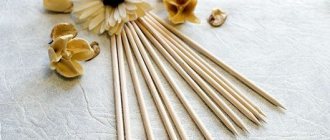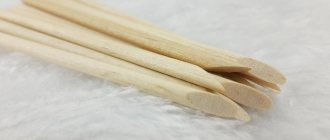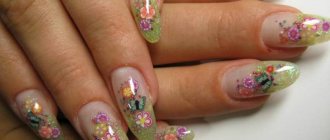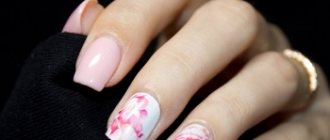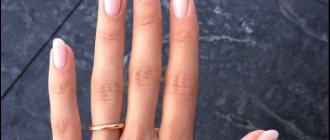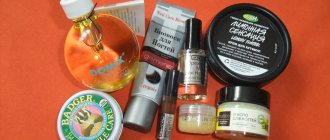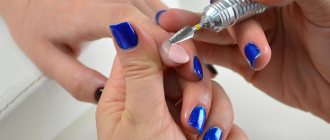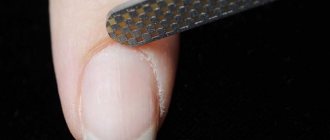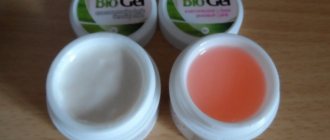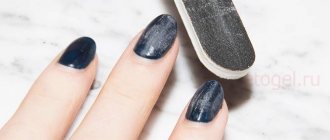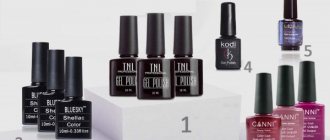What are orange sticks?
Orange nail sticks are thin wooden sticks that are used for manicures, pedicures and gel polish removal. They work with nail plates, cuticles and pterygium. The tool is equally suitable for home and professional use.
Why are orange sticks called that and what are they made of?
Everything is very simple! These miracle sticks are made from orange tree bark. Why did they choose this particular wood to create them? The thing is that the orange tree has a unique structure - soft and dense at the same time. That is why the sticks are durable, protected from delamination and cannot injure the nail plate. Citrus bark also has natural antiseptic properties, which makes it even more valuable.
What do orange sticks look like?
Orange sticks have an elongated cylindrical shape, they are thin, their length varies from 8 to 18 cm. One end of the stick is sharp, and the other is beveled flat.
How much do orange sticks cost?
This is a fairly budget product, its cost ranges from 20 to 400 rubles, depending on the length of the tool and the quantity in the package.
Why are orange sticks needed in manicure?
Manicure in the form that it is in our modern understanding was brought into fashion by the French. They also produced the first manicure kit, which included an orange tree stick. Externally, it is a rounded rod, one end of which is flat, the other is beveled and pointed. They vary in length from 9 to 18 centimeters, in thickness from 3 to 5 millimeters.
A question that probably interests many is why exactly orange sticks are used for manicure. It is believed that the orange tree has disinfecting properties, which come in handy when treating the nail plates and cuticle area. In addition, its wood does not delaminate. The density of the stick is sufficient to gently move away dead skin, and its inherent softness does not injure the surface of the nails during the treatment process.
Despite all its simplicity, the orange stick has quite a wide range of uses:
- Pushes back and removes the cuticle during a European manicure;
- Cleanses the space under the nails;
- Used as a decorative tool.
What are orange sticks for?
Orange sticks are an almost universal tool, truly necessary for everyone who does manicure: both masters and non-professionals. So, here are the main functions of orange sticks:
Cleaning your nails
The tool can easily remove dirt under the nails: just swipe with a thin pointed tip, which will collect all the dirt.
Pushing back the cuticle
We can say that pushing back the cuticle is one of the main tasks of the orange stick. This is done with a wide beveled end. The stick glides wonderfully over the nail plate and delicately pushes back the softened skin, so it is a must-have in the process of European unedged manicure. Thanks to its texture, it is absolutely safe for the cuticle and side ridges and cannot injure them.
Cleaning off the pterygium
Another important function of the wand is that it can not only push back the cuticle, but also clean off the pterygium with vigorous movements.
Cuticle removal
The sticks are easy to remove cuticles. Thoroughly soften the skin with a remover and then carefully separate the keratinized tissue from the main layer of the cuticle.
Removing gel polish
The sticks also help in the process of removing gel polish by soaking. After the old coating has softened, you can pry it with the beveled end and carefully remove it. In this case, the stick simply cannot scratch the nail plate, unlike metal tools.
During the process of nail extension
Firstly, you can remove softened acrylic with sticks, secondly, you can use them to lay out forms for acrylic modeling, and thirdly, when attaching tips and applying glue to them.
Instead of dots
Don't have a Dots handy? No problem! Orange sticks will come to the rescue - with the sharp end you can pick up the necessary material and work pointwise.
For painting nails
Also, the sharp tip can be used for the finest painting, for example, using the “wet” technique.
For attaching decor
You can use an orange stick to pick up glitter, pick up some small element (rhinestones, pearls) and transfer it to your nails.
Correction of applied gel polish
An orange stick is very convenient to remove the crusty coating from the skin before it polymerizes.
Why and how to use an orange stick
1. Cleaning your nails.
In order to clean the inner surface of the free edge of the nail, it is convenient to use an orange stick. Take an orange stick and gently run the pointed edge under your nail. Don't forget to change the orange sticks often during this procedure.
2. Pushing back the cuticle.
With
a European manicure,
the cuticle is not cut, as with a regular manicure, but is only carefully moved away from the nail plate.
After a relaxing nail bath or after applying a special cuticle care product, you can push back the cuticles using a rubber or metal spatula. But, firstly, this is quite unhygienic. And secondly, there is a chance of damaging the cuticle. By pushing back the cuticle with the blunt end of an orange stick, you solve both problems at once. Using an orange stick will not damage the cuticle, will not cause infection and, as a result, will avoid the appearance of hangnails
and inflammation.
3. Cuticle removal.
Sometimes keratinized cuticle cells need to be removed after softening. Use the sharp end of an orange stick for this. Gently pry up the keratinized edge of the cuticle and separate it from the base layer. The main thing in this procedure is to soften the skin well. Try not to use extra effort when removing cuticles; with an orange stick you can easily remove only the excess.
4. Use for nail decoration
. An orange stick is very convenient for applying various small elements when applying glitter and rhinestones to nails. You can also use an orange stick to paint your nails with nail polish. We can say with confidence that an orange stick is a universal tool for decorative manicure.
Orange sticks come in different sizes. This applies to both the length of the stick and its thickness. The length of orange sticks varies from 9cm to 18cm.
The thickness of an orange stick usually ranges from 3-5mm. Choose the optimal length and thickness of the orange stick for yourself, then using this wonderful tool will be easy and convenient for you.
The orange stick is an individual and disposable product.
An orange tree, like any other, absorbs moisture and is difficult to treat with antiseptics, so an orange stick can become a source of infection if reused; do not reuse it.
To ensure that you can use only high-quality manicure items, purchase orange sticks, like other hygiene products, only in specialized stores or cosmetic departments.
The process of creating a manicure requires the presence of many special tools. Today the article is devoted to such an important, but at the same time absolutely unpretentious, accessory as an orange stick and how to use it. It finds application both in the hands of professional nail technicians and lovers of home nail care procedures. Why is orange wood used? Why do you need a wooden rod?
What can replace orange sticks?
The answer to this question lies the meaning of using orange sticks: in order to replace this one universal tool, you will need many devices! So, the stick can be replaced:
- pusher if you push back the cuticle;
- nail scissors to remove cuticles if you are doing a trimmed manicure instead of an unedged one with a remover;
- wax pencil during the decorating process;
- the back of the spatula for cleaning the nail;
- with a brush during painting;
- dots for design creation.
Is it possible to replace orange sticks with silicone ones?
In addition to orange ones, there are also silicone sticks with a plastic tip. They are usually used by girls with overly sensitive skin. If you have normal skin, it is better to use classic orange sticks, because the plastic does not move well along the surface of the nail plate, as a result of which you can press harder on the tool or make sharper movements, which can ultimately lead to injury to the cuticle or nail.
Where to buy orange sticks?
We strictly recommend buying orange sticks only from trusted stores! Otherwise, there is a risk of buying expired goods in damaged packaging. And we remember about the absorbency of sticks - under inappropriate conditions they can become a source of pathogenic bacteria and infections.
How were orange sticks invented?
The history of orange sticks dates back to 1830, when King Louis Philippe developed a hangnail on his finger. The court doctor was ordered to remove the hangnail, and then the doctor developed a set for hand care. After that, manicure went to the masses, and ready-made manicure sets became very popular. Then they included powder, a suede nail file, a special hand cream and, of course, an orange stick, which is included in all standard sets to this day.
Orange sticks for manicure: how to use the tool?
An orange stick is a very simple, but multifunctional item. The scope of application of the tool is quite wide. Let's look at the main functions and give important recommendations on how to use orange manicure sticks.
How are chopsticks used?
- To push back the cuticle.
For unedged (European) manicure, which is increasingly gaining popularity, this tool is indispensable! An orange stick is the best way to gently push back the cuticle without damaging the thin skin. Perform the procedure with the blunt end of a stick.
- Sometimes metal tools are used for these purposes. But it is known that the cuticle is very thin, and the base of the nail is a painful area. Therefore, any carelessness in movements can lead to the appearance of wounds on delicate skin and pain.
The orange stick is also used in Brazilian manicure.
- For removing cuticles.
Have you decided to use special softening agents to remove cuticles? An orange stick can be used to easily clean the base of keratinized cells without damaging the nail growth area. Proceed with removal only when you are sure that the cuticle has softened well. Carefully pry the layer with the rounded tip of the stick. Don't press too hard on the skin or overdo it. If the remnants of the cuticle are difficult to remove, then you should study the process technology well or replace the product with a more effective one.
- For removing gel polish.
The technique of cleaning a record from a durable coating requires removing the remaining product with a hard tool. Often inexperienced and impatient beginners scratch their nails. An orange stick will help you gently and carefully remove the gel polish without damaging the plates. Follow the instructions for using gel polish remover exactly. Clean the nail carefully, without haste.
- To clean the subungual space.
It is very convenient to use a stick to clean the free edge of any dirt that has accumulated there. This can be done with a sharp tip. It is useful to give your hands a warm bath before cleaning.
- For decorating the base.
With a thin stick it is convenient to pick up rhinestone beads and “sit” them on the glue. The sharp tip can be used to paint the surface of the plate. An orange stick is also used, for example, in caviar manicure to level out broths, as well as to create patterns on wet gel polish.
- When doing nail extensions.
The stick is used as an auxiliary tool for creating a shape, as well as for removing artificial plates.
Orange sticks: life hacks
Don't like the shape of the wand tip? Apply the desired effect using a coarse abrasive file!
Do you decorate your nails with an orange stick? Then apply a small amount of clear polish/gel polish or glue to the tip, this will make it easier to transfer decorative elements to the nail plate.
Orange sticks for manicure
Among the many devices that are needed, you should pay attention to wooden sticks made from orange tree wood. I would like to note that the modern version was invented by the French, and they were the first to use orange sticks and complete manicure sets with them.
The question immediately arises, why from orange or, say, not from oak, poplar or any other type of wood? Everything is very simple here. The fact is that in addition to the fact that the tree generously gifts us with these tasty and aromatic fruits, the wood itself is also useful; its structure is quite dense, but soft, so the finished sticks do not delaminate and do not injure our nails. In addition, wood has antiseptic properties, which, by the way, is a must when performing a manicure.
Why orange wood sticks?
So, we have found out why orange wood is used for sticks, now we will look in more detail at what and how these sticks are used.
In appearance, these are ordinary sticks, only on one side there is a pointed nose, and on the other it has a flat shape. Using a coarse abrasive file, you can restore the shape of the stick. Orange sticks vary in length, their size ranges from 9 to 18 cm, but their thickness ranges from 3 to 5 mm.
On sale you can find the same sticks, but with multi-colored coating on the tips, or even sticks with a rubber tip, they are also designed for removing thin cuticles.
It is worth remembering that orange sticks absorb moisture well
, after use, they cannot be treated with antiseptics, so with each new procedure you should take a new stick.
